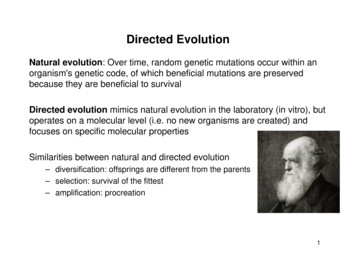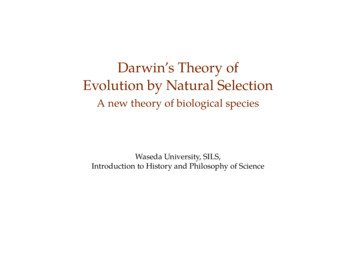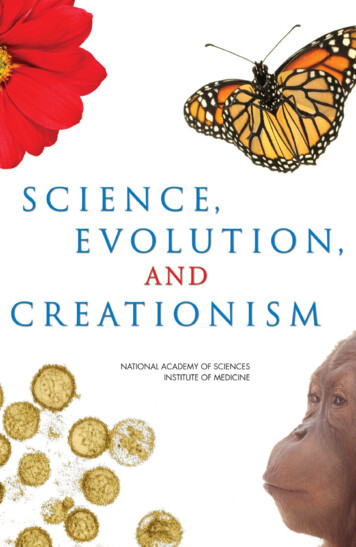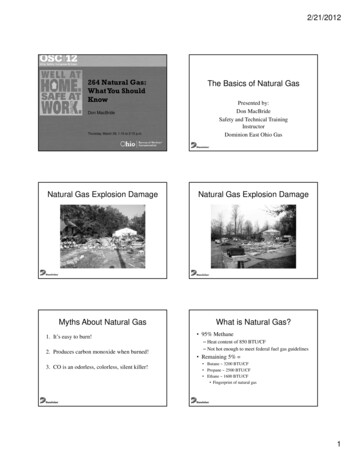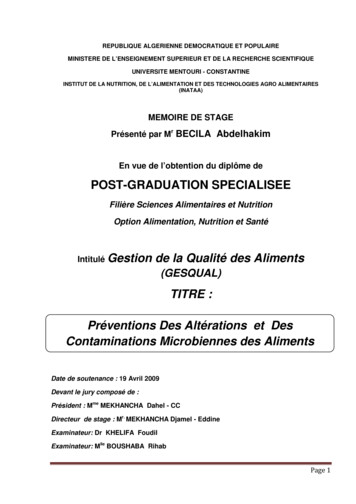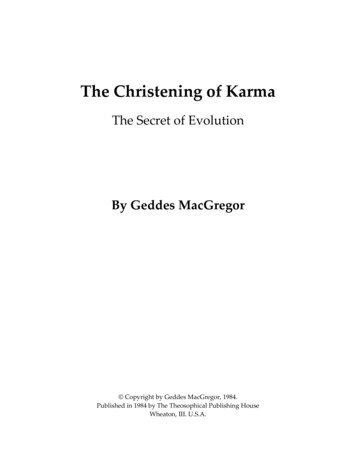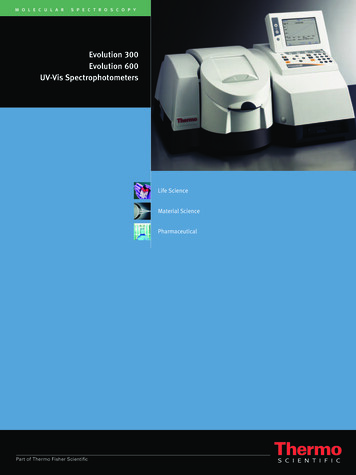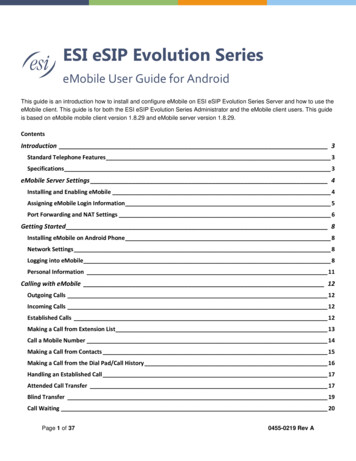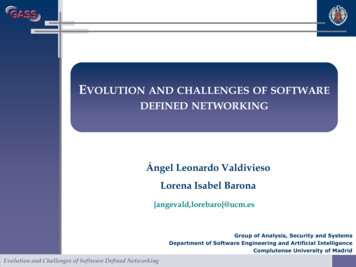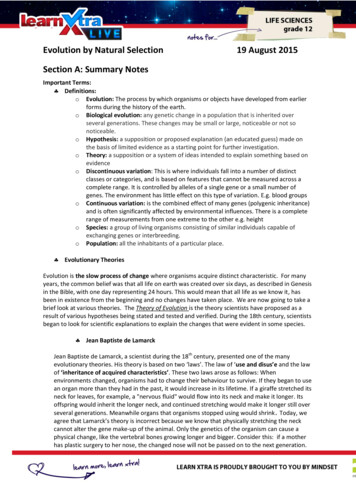
Transcription
Evolution by Natural Selection19 August 2015Section A: Summary NotesImportant Terms: Definitions:o Evolution: The process by which organisms or objects have developed from earlierforms during the history of the earth.o Biological evolution: any genetic change in a population that is inherited overseveral generations. These changes may be small or large, noticeable or not sonoticeable.o Hypothesis: a supposition or proposed explanation (an educated guess) made onthe basis of limited evidence as a starting point for further investigation.o Theory: a supposition or a system of ideas intended to explain something based onevidenceo Discontinuous variation: This is where individuals fall into a number of distinctclasses or categories, and is based on features that cannot be measured across acomplete range. It is controlled by alleles of a single gene or a small number ofgenes. The environment has little effect on this type of variation. E.g. blood groupso Continuous variation: is the combined effect of many genes (polygenic inheritance)and is often significantly affected by environmental influences. There is a completerange of measurements from one extreme to the other e.g. heighto Species: a group of living organisms consisting of similar individuals capable ofexchanging genes or interbreeding.o Population: all the inhabitants of a particular place. Evolutionary TheoriesEvolution is the slow process of change where organisms acquire distinct characteristic. For manyyears, the common belief was that all life on earth was created over six days, as described in Genesisin the Bible, with one day representing 24 hours. This would mean that all life as we know it, hasbeen in existence from the beginning and no changes have taken place. We are now going to take abrief look at various theories. The Theory of Evolution is the theory scientists have proposed as aresult of various hypotheses being stated and tested and verified. During the 18th century, scientistsbegan to look for scientific explanations to explain the changes that were evident in some species. Jean Baptiste de LamarckJean Baptiste de Lamarck, a scientist during the 18th century, presented one of the manyevolutionary theories. His theory is based on two ‘laws’. The law of ‘use and disus’e and the lawof ‘inheritance of acquired characteristics’. These two laws arose as follows: Whenenvironments changed, organisms had to change their behaviour to survive. If they began to usean organ more than they had in the past, it would increase in its lifetime. If a giraffe stretched itsneck for leaves, for example, a "nervous fluid" would flow into its neck and make it longer. Itsoffspring would inherit the longer neck, and continued stretching would make it longer still overseveral generations. Meanwhile organs that organisms stopped using would shrink. Today, weagree that Lamarck’s theory is incorrect because we know that physically stretching the neckcannot alter the gene make-up of the animal. Only the genetics of the organism can cause aphysical change, like the vertebral bones growing longer and bigger. Consider this: if a motherhas plastic surgery to her nose, the changed nose will not be passed on to the next generation.
Darwin’s Theory of EvolutionCharles Darwin wrote a book called ‘On the origin of species’, published in 1859. Darwin wrotethat organisms evolve by small, gradual changes that take place over many successivegenerations to ensure survival. Darwin’s theory arose from 4 main observations: Organisms of a species produce a large number of offspringThe offspring show a great deal of variationOf the large number of offspring produced, only a few surviveCharacteristics are inherited from surviving parents to offspring.His theory rests on five principles:1.All species show structural and functional variations that affect the organism’schances of survival.2.Each species has the ability to reproduce and, if the population of the species is notcontrolled, they will eventually run out of food and living space.3.Individuals in the species that have advantageous variations, will survive the battle forfood, mates and living space.4.Constant selection of the better-adapted and stronger individuals, and the eliminationof the weaker ones, result in the evolutionary changes that occur.5.The stronger individuals pass their genes on to the next generation. (Survival of thefittest)Darwin used his 5 principles to explain that the present species on earth today, are modifieddescendents from the species of the past.Evolution can be explained as the constant change that has taken place. Darwin’s book was thefirst theory about evolution to be published. His theory was supported by scientific evidence andwas regarded as credible.The PROCESS of change was called NATURAL SELECTION.The combined LONG-TERM changes in the species were called EVOLUTION.During Darwin’s travels, he spent time on the Galapagos Islands (about 965 km west of Ecuador)where he studied the fauna and flora (plants and animals). He carefully recorded the appearanceof the Galapagos finches. There are 14 species of dull, unremarkable looking birds, whichevidently come from a common ancestor where each species is specialised for a specific diet andhabitat. Many years after his trip on the HMS Beagle, Darwin drew the conclusion that thevariation between the finch species was due to lifestyle and behaviour. He suggested that thisproved his theory of natural selection.
Darwin’s finches on the Galapagos Islands Punctuated equilibriumThe punctuated equilibrium theory of evolution, states that living populations show no changesover long periods of time, but stay in a kind of equilibrium.o According to punctuated equilibrium, evolution is not gradualo Evolution involved long periods of time where species do not change or change verylittle (equilibrium).o Short periods of rapid change through natural selection alternate with equilibrium.o New species are formed in a short period of time relative to equilibriumo Absence of transitional fossils (missing links)indicates the period of rapid change.Please learn terms like Allopatric Speciation, Variation, useful, harmless and harmful Mutations, ,Artificial Selection and Natural Selection, Geographical Barriers, and link this to allopatric speciation,homologous organs. Evidence of EvolutionInformation and research to support the concept of continual change has come from sources likegeology, anatomy, embryology, genetics and physiology.The word fossil is derived from Latin and is defined as the imprint, traces or preserved remains of anorganism that once lived. Fossilisation is the process that took place to produce the fossil. Fossil record: Archaeologists study and trace the fossil remains in rock strata. Thestudy of fossils is called palaeoecology. Fossils found laid down in one stratum arecompared to strata from later periods. A progression of forms can be clearly seen.Organisms without a backbone show modifications and development into organisms
that have a backbone. Archaeologists have also recorded fish that have modifiedinto amphibians. Amphibians modified into reptiles and the reptiles modified intomammals. Fossil evidence supports these progressions. Modification by descent (homologous structures): Anatomical evidence is derivedfrom the study of the details of the structures of body parts and systems oforganisms that belong to a phylum. There is a similarity in the structure of thepentadactyl limb for example the flipper of a dolphin, the wing of a bird and thehuman arm. The bones, muscles and nerves are arranged in a similar way. Whenthere is a similarity of the formation of a body part or organ due to a commonevolutionary origin, it is termed a homologous organ.Adaptation of the pentadactyl limbs of mammals (Vivlia publishers – Viva Grade 12 Life Science2008) Physiological evidence shows that the chemicals found in the cytoplasm of plant and animalcells are similar. When studying the nucleus, the DNA and RNA are similar in plants andanimals. Biogeography the distribution of species in relation both to geography and to other species.Biogeography comprises two disciplines: historical biogeography, which is concerned withthe origins and evolutionary histories of species on a long time scale, and ecologicalbiogeography, which deals with the current interactions of species with their environmentsand each other on a much shorter time scale.
Section B: Practice QuestionsQuestion 1Study the passage below and answer the questions that follow.CHARLES DARWINIn 1831 Charles Darwin set out on a trip around the world in the HMS Beagle.At the Cape VerdeIslands, he saw the fossil remains of sea creatures in thecliffs, many metres above sea level.The unique forms of life he found on the Galapagos Islands, such as the gianttortoises, convincedhim that living organisms had evolved over many millionsof years. He noticed that these tortoiseswere quite different from those foundelsewhere in the world. Each island also had a distinct typeof tortoise,differing in the shape of the shell and mating behaviour.1.1.Explain how Darwin would have used the example of the tortoises to explain speciation. (4)1.2.How do fossils provide evidence for evolution?(2)1.3.Give ONE reason why there are gaps in the fossil records.(2)[8]Question 2The flow diagram below shows various sources of genotypic variation.
2.1.2.2.2.3.2.4.Name the process labelled C that is a source of genotypic variation.Name the phases of meiosis, labelledA and B, respectively.Name the TWO types of mutations, labelledD and E, respectively.State what is meant by each of the following:(a) harmful mutations(b) harmless mutations(c) helpful mutations(1)(2)(2)(1)(1)(1)[11]Question 3Study the diagram below and answer the questions that follow.3.1.3.2.Explain the phenomenon illustrated in the diagram.Describe the observations on which Darwin based his theory of evolution.Question 4:(2)(4)[6]10 minutesBefore the Industrial Revolution took place in Britain in the 19th century, light-coloured moths thatblended with the lichen-covered bark of trees, were far more common than dark-coloured moths.However, pollution from factories killed the lichens on the trees leaving their dark bark exposed. Thelight-coloured moths were easily identified against the black background. The dark-coloured mothsthat were easily camouflaged on the dark bark, soon became far more common than the lightervarieties. Now that pollution is decreasing the light-coloured moths are increasing in numbers again.Study the graph on the next page that shows the changes in the percentage of dark-coloured moths.4.1.What was the percentage of the dark-coloured moths in 1970?(1)4.2.What is the general relationship between the dark-coloured moth population and pollutionfrom 1965 to 1985?(2)4.3.Explain the relationship mentioned in QUESTION 8.2.(2)4.4.Briefly outline Lamarck's theory of evolution.(5)[10]
Question 5(Taken from DoE November 2008 Paper 2)Scientists believe that variation in populations can lead to the formation of new species.5.1.List FOUR sources of variation in populations.5.2.Explain how speciation occurs if a population becomes separated into two groups by ageographical barrier such as a mountain.(4)(6)[10]Question 5(Taken from DoE Feb/March 2010 Paper 2)One of the observations Darwin made during his study of pigeons was about artificial selection. In1859 Darwin and Wallace jointly proposed that new species could develop by a process of naturalselection. Using examples, describe natural and artificial selection and also highlight the differencesbetween these two processes.ContentSynthesis(17)(3)[20]
Section C: SolutionsQuestion 11.1.During continental drift the tortoise populations were isolated/separated from the original population on different islands living under differentenvironmental conditions and through natural selection developed into newspecies not able to interbreed after a period of time (Any 4)1.2Fossils provide evidence of life forms that existed in the past/that are nowextinct Intermediate forms of organisms have been discovered that illustratethe changing forms of plants/animals (Any 2)(2)1.3Only a few of the ancient organisms are preserved as fossils because theyneed to be covered soon after death otherwise they will be decomposed bybacteria Only organisms with a solid and resistant skeleton are easilypreserved We have not found all the fossils that exist in the earth (Any 1 x 2) (Markers will mark first ONE only)(2)(4)[8]Question 22.1Sexual Reproduction/Fusion (1)2.2A Prophase I B Metaphase 1 (2)2.3D – Gene mutation E – Chromosome mutation (2)2.4(a) Harmful: the mutated organism dies and the harmful characteristics are not passed on tothe next generation (1)(b) Harmless : has no effect on the structure and functioning of the organism (1)(c) Helpful: advantageous /sometimes the advantageous mutation wipes out all the otheralleles controlling the same characteristic within the population(1)Question 33.1Natural selection– those organisms with the most beneficial traits are more likely to surviveand reproduce .(2)3.2Darwin’s observations were:Organisms of a species produce a large number of offspringThe offspring show a great deal of variationOf the large number of offspring only a small number survive because of competition forresources/survival of the fittestCharacteristics are inheritable from parent to offspring(4)Question 44.193 % (accept 92 - 95)(1)4.2- As the pollution decreased - the percentage of the dark-coloured moths also decreased (2)4.3- The dark-coloured moths are not being camouflaged /can easily be seenagainst the light lichen-covered bark- and have become easier targets/prey for birds (2)4.4Lamarck‘s law of use and disuse states that use of an organ or structure in an organism willresult in that organ /structure changing (evolving) for the benefit of the organism. The law ofinheritance of acquired characteristics then implies that the changes made to the parentthrough use and disuse will be inherited by the offspring.
Question 55.1- Random assortment /segregation/recombination of chromosomes during meiosis information of gametes- Crossing over the- Chance/random fertilisation of gametes /sexual reproduction- Mutation - Outbreeding /Gene flow(Mark first FOUR answers only in learner’s script)5.2.(4)- Within each of the two groups there is variation - Each group undergoes natural selection - as a result of varying environmental conditions - and develops differently - genotypically and phenotypically - since the geographical barrier prevents gene flow /reproduction between the twopopulations- The differences that develop between the two populations prevent them from interbreeding even if they were to mix- such that one or both of the groups becomes a new species any 6 (6)Question 6Natural selection e.g. Finches* /or any other example- Organisms of a particular species shows a great deal of variation - Some individuals may have characteristics /any example that are favourable /some individualsmay be adapted to the environment- Others may have characteristics/any example that are unfavourable - Selective pressure by the environment due to competition /changing environmental conditions- Organisms with favourable characteristics survive and reproduce - to pass favourable characteristics to their offspring - while organisms with unfavourable characteristics will die out - Over time the whole population will have this favourable trait - Over time these organisms might develop genotypically and phenotypically independently - into different species which cannot interbreed*Compulsory markMax 7 1 for compulsory mark(8)Artificial selection e.g. Production of improved fruit/ meat production* - Organisms of a particular species/any example show a great deal of variation - Humans select organisms- with a particular desirable characteristic - and interbreed them- with other organisms that also have the same desirable characteristic- to improve this characteristic further in the offspring- They may also choose organisms with different desirable characteristics- to get offspring with a combination of these desirable characteristics*Compulsory markMax 4 1 for example*(5)
Differences between natural and artificial selectionNatural SelectionArtificial selectionSelective pressure by the environment Humans select the desirable characteristic Selection is in response to suitability to theenvironment Selection is in response to satisfying humanneeds Organisms can rely on their own in theenvironment (since they were selected on thebasis of their suitability to the environment)Organisms may not often survive on their own in the environment (since they were selected onthe basis of human needs and not on suitability tothe environment)No human effort / cost involved Could be labour intensive / expensiveAny 2 (2 x 2 4)
Evolution can be explained as the constant change that has taken place. Darwins book was the first theory about evolution to be published. His theory was supported by scientific evidence and was regarded as credible. The PROCESS of change was called NATURAL SELECTION. The combined LONG-TERM changes in the species were called EVOLUTION.
